Altered patterns of global protein synthesis and translational fidelity in RPS15-mutated chronic lymphocytic leukemia
- PMID: 30181176
- PMCID: PMC6410914
- DOI: 10.1182/blood-2017-09-804401
Altered patterns of global protein synthesis and translational fidelity in RPS15-mutated chronic lymphocytic leukemia
Abstract
Genomic studies have recently identified RPS15 as a new driver gene in aggressive and chemorefractory cases of chronic lymphocytic leukemia (CLL). RPS15 encodes a ribosomal protein whose conserved C-terminal domain extends into the decoding center of the ribosome. We demonstrate that mutations in highly conserved residues of this domain affect protein stability, by increasing its ubiquitin-mediated degradation, and cell-proliferation rates. On the other hand, we show that mutated RPS15 can be loaded into the ribosomes, directly impacting on global protein synthesis and/or translational fidelity in a mutation-specific manner. Quantitative mass spectrometry analyses suggest that RPS15 variants may induce additional alterations in the translational machinery, as well as a metabolic shift at the proteome level in HEK293T and MEC-1 cells. These results indicate that CLL-related RPS15 mutations might act following patterns known for other ribosomal diseases, likely switching from a hypo- to a hyperproliferative phenotype driven by mutated ribosomes. In this scenario, loss of translational fidelity causing altered cell proteostasis can be proposed as a new molecular mechanism involved in CLL pathobiology.
© 2018 by The American Society of Hematology.
Conflict of interest statement
Conflict-of-interest disclosure: The authors declare no competing financial interests.
Figures

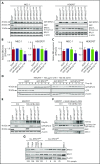
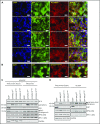
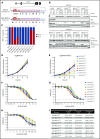
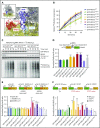
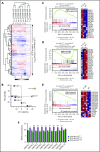
Comment in
-
Not so lost in translation: RPS15 mutations in CLL.Blood. 2018 Nov 29;132(22):2317-2319. doi: 10.1182/blood-2018-09-875179. Blood. 2018. PMID: 30498067 No abstract available.
Similar articles
-
RPS15 mutations rewire RNA translation in chronic lymphocytic leukemia.Blood Adv. 2021 Jul 13;5(13):2788-2792. doi: 10.1182/bloodadvances.2020001717. Blood Adv. 2021. PMID: 34251413 Free PMC article.
-
Whole-exome sequencing in relapsing chronic lymphocytic leukemia: clinical impact of recurrent RPS15 mutations.Blood. 2016 Feb 25;127(8):1007-16. doi: 10.1182/blood-2015-10-674572. Epub 2015 Dec 16. Blood. 2016. PMID: 26675346 Free PMC article.
-
Eukaryotic protein uS19: a component of the decoding site of ribosomes and a player in human diseases.Biochem J. 2021 Mar 12;478(5):997-1008. doi: 10.1042/BCJ20200950. Biochem J. 2021. PMID: 33661277 Review.
-
Ribosomal Lesions Promote Oncogenic Mutagenesis.Cancer Res. 2019 Jan 15;79(2):320-327. doi: 10.1158/0008-5472.CAN-18-1987. Epub 2018 Nov 27. Cancer Res. 2019. PMID: 30482776 Free PMC article.
-
Role of ribosomal protein mutations in tumor development (Review).Int J Oncol. 2016 Apr;48(4):1313-24. doi: 10.3892/ijo.2016.3387. Epub 2016 Feb 9. Int J Oncol. 2016. PMID: 26892688 Free PMC article. Review.
Cited by
-
TFIIH mutations can impact on translational fidelity of the ribosome.Hum Mol Genet. 2023 Mar 20;32(7):1102-1113. doi: 10.1093/hmg/ddac268. Hum Mol Genet. 2023. PMID: 36308430 Free PMC article.
-
Ribosomal proteins and human diseases: molecular mechanisms and targeted therapy.Signal Transduct Target Ther. 2021 Aug 30;6(1):323. doi: 10.1038/s41392-021-00728-8. Signal Transduct Target Ther. 2021. PMID: 34462428 Free PMC article. Review.
-
RPS15 mutations rewire RNA translation in chronic lymphocytic leukemia.Blood Adv. 2021 Jul 13;5(13):2788-2792. doi: 10.1182/bloodadvances.2020001717. Blood Adv. 2021. PMID: 34251413 Free PMC article.
-
Quality control ensures fidelity in ribosome assembly and cellular health.J Cell Biol. 2023 Apr 3;222(4):e202209115. doi: 10.1083/jcb.202209115. Epub 2023 Feb 15. J Cell Biol. 2023. PMID: 36790396 Free PMC article. Review.
-
Targeting mRNA translation aberrations: A novel approach for therapy in chronic lymphocytic leukemia.Cancer Commun (Lond). 2023 Dec;43(12):1373-1376. doi: 10.1002/cac2.12493. Epub 2023 Oct 6. Cancer Commun (Lond). 2023. PMID: 37803910 Free PMC article. No abstract available.
References
-
- Fabbri G, Dalla-Favera R. The molecular pathogenesis of chronic lymphocytic leukaemia. Nat Rev Cancer. 2016;16(3):145-162. - PubMed
-
- Hamblin TJ, Davis Z, Gardiner A, Oscier DG, Stevenson FK. Unmutated Ig V(H) genes are associated with a more aggressive form of chronic lymphocytic leukemia. Blood. 1999;94(6):1848-1854. - PubMed
-
- Damle RN, Wasil T, Fais F, et al. . Ig V gene mutation status and CD38 expression as novel prognostic indicators in chronic lymphocytic leukemia. Blood. 1999;94(6):1840-1847. - PubMed
-
- Sutton LA, Rosenquist R. The complex interplay between cell-intrinsic and cell-extrinsic factors driving the evolution of chronic lymphocytic leukemia. Semin Cancer Biol. 2015;34:22-35. - PubMed
Publication types
MeSH terms
Substances
Grants and funding
LinkOut - more resources
Full Text Sources
Other Literature Sources
Molecular Biology Databases

